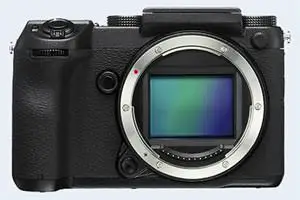Nikon D850 vs Fujifilm GFX 50S
The Nikon D850 and the Fujifilm GFX 50S are two professional cameras that were announced, respectively, in July 2017 and September 2016. The D850 is a DSLR, while the GFX 50S is a mirrorless interchangeable lens camera. The cameras are based on a full frame (D850) and a medium format (GFX 50S) sensor. The Nikon has a resolution of 45.4 megapixels, whereas the Fujifilm provides 51.1 MP.
Below is an overview of the main specs of the two cameras as a starting point for the comparison.

Check D850 price at
amazon.com

Check GFX 50S offers at
ebay.com
Going beyond this snapshot of core features and characteristics, what are the differences between the Nikon D850 and the Fujifilm GFX 50S? Which one should you buy? Read on to find out how these two cameras compare with respect to their body size, their imaging sensors, their shooting features, their input-output connections, and their reception by expert reviewers.
Body comparison
An illustration of the physical size and weight of the Nikon D850 and the Fujifilm GFX 50S is provided in the side-by-side display below. The two cameras are presented according to their relative size. Three consecutive views from the front, the top, and the rear side are shown. All width, height and depth measures are rounded to the nearest millimeter.
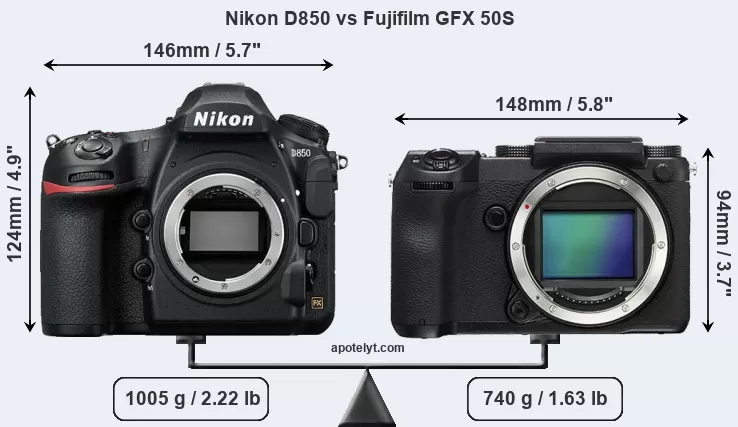

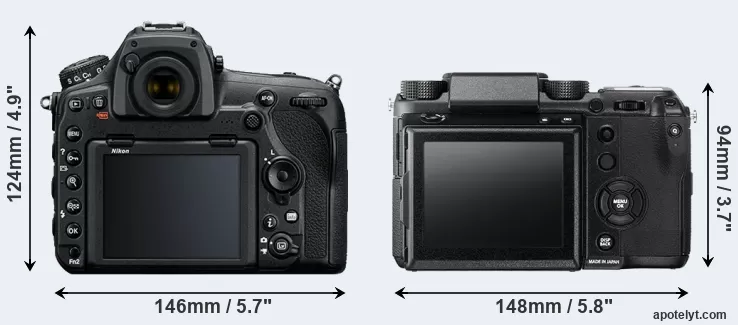
If the front view area (width x height) of the cameras is taken as an aggregate measure of their size, the Fujifilm GFX 50S is notably smaller (23 percent) than the Nikon D850. Moreover, the GFX 50S is markedly lighter (26 percent) than the D850. In this context, it is worth noting that both cameras are splash and dust-proof and can, hence, be used in inclement weather conditions or harsh environments.
The above size and weight comparisons are to some extent incomplete since they do not consider the interchangeable lenses that both of these cameras require. Hence, you might want to study and compare the specifications of available lenses in order to get the full picture of the size and weight of the two camera systems.
Concerning battery life, the D850 gets 1840 shots out of its Nikon EN-EL15a battery, while the GFX 50S can take 400 images on a single charge of its Fujifilm NP-T125 power pack.
The following table provides a synthesis of the main physical specifications of the two cameras and other similar ones. In case you want to display and compare another camera duo, you can use the CAM-parator app to select your camera combination among a large number of options.

| Camera Model |
Camera Width |
Camera Height |
Camera Depth |
Camera Weight |
Battery Life |
Weather Sealing |
Camera Launch |
Launch Price (USD) |
Street Price |
||
|---|---|---|---|---|---|---|---|---|---|---|---|
| 1. | Nikon D850 | 146 mm | 124 mm | 79 mm | 1005 g | 1840 | Y | Jul 2017 | 3,299 | amazon.com | |
| 2. | Fujifilm GFX 50S | 148 mm | 94 mm | 91 mm | 740 g | 400 | Y | Sep 2016 | 6,499 | ebay.com | |
| 3. | Canon 5DS | 152 mm | 116 mm | 76 mm | 930 g | 700 | Y | Feb 2015 | 3,699 | ebay.com | |
| 4. | Canon 5DS R | 152 mm | 116 mm | 76 mm | 930 g | 700 | Y | Feb 2015 | 3,699 | ebay.com | |
| 5. | Fujifilm GFX 50R | 161 mm | 97 mm | 66 mm | 775 g | 400 | Y | Sep 2018 | 4,499 | ebay.com | |
| 6. | Fujifilm GFX 50S II | 150 mm | 104 mm | 87 mm | 900 g | 440 | Y | Sep 2021 | 3,999 | amazon.com | |
| 7. | Hasselblad X1D II | 148 mm | 97 mm | 70 mm | 766 g | .. | Y | Jun 2019 | 5,750 | ebay.com | |
| 8. | Leica M10 | 139 mm | 80 mm | 39 mm | 660 g | 210 | Y | Jan 2017 | 6,595 | ebay.com | |
| 9. | Leica SL | 147 mm | 104 mm | 39 mm | 847 g | 400 | Y | Oct 2015 | 7,450 | ebay.com | |
| 10. | Nikon D5 | 160 mm | 159 mm | 92 mm | 1415 g | 3780 | Y | Jan 2016 | 6,499 | ebay.com | |
| 11. | Nikon D600 | 141 mm | 113 mm | 82 mm | 850 g | 900 | Y | Sep 2012 | 2,099 | ebay.com | |
| 12. | Nikon D610 | 141 mm | 113 mm | 82 mm | 850 g | 900 | Y | Oct 2013 | 1,999 | ebay.com | |
| 13. | Nikon D800 | 146 mm | 123 mm | 82 mm | 1000 g | 900 | Y | Feb 2012 | 2,999 | ebay.com | |
| 14. | Nikon D800E | 146 mm | 123 mm | 82 mm | 1000 g | 900 | Y | Feb 2012 | 3,299 | ebay.com | |
| 15. | Nikon D810 | 146 mm | 123 mm | 82 mm | 980 g | 1200 | Y | Jun 2014 | 3,299 | ebay.com | |
| 16. | Nikon Df | 144 mm | 110 mm | 67 mm | 760 g | 1400 | Y | Nov 2013 | 2,749 | ebay.com | |
| 17. | Sony A99 II | 143 mm | 104 mm | 76 mm | 849 g | 490 | Y | Sep 2016 | 3,199 | ebay.com | |
| Note: Measurements and pricing do not include easily detachable parts, such as add-on or interchangeable lenses or optional viewfinders. | |||||||||||
The price is, of course, an important factor in any camera decision. The listed launch prices provide an indication of the market segment that the manufacturer of the cameras have been targeting. The D850 was launched at a markedly lower price (by 49 percent) than the GFX 50S, which puts it into a different market segment. Normally, street prices remain initially close to the MSRP, but after a couple of months, the first discounts appear. Later in the product cycle and, in particular, when the replacement model is about to appear, further discounting and stock clearance sales often push the camera price considerably down.
Sensor comparison
The size of the imaging sensor is a crucial determinant of image quality. A large sensor will tend to have larger individual pixels that provide better low-light sensitivity, wider dynamic range, and richer color-depth than smaller pixel-units in a sensor of the same technological generation. Moreover, a large sensor camera will give the photographer more control over depth-of-field in the image and, thus, the ability to better isolate a subject from the background. On the downside, larger sensors are more costly to manufacture and tend to lead to bigger and heavier cameras and lenses.
Of the two cameras under consideration, the Nikon D850 features a full frame sensor and the Fujifilm GFX 50S a medium format sensor. The sensor area in the GFX 50S is 69 percent bigger. As a result of these sensor size differences, the cameras have a format factor of, respectively, 1.0 and 0.79. The sensor in the D850 has a native 3:2 aspect ratio, while the one in the GFX 50S offers a 4:3 aspect.
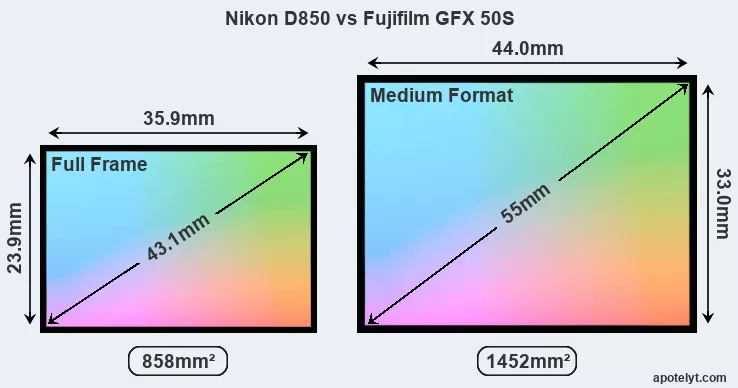
With 51.1MP, the GFX 50S offers a higher resolution than the D850 (45.4MP), but the GFX 50S nevertheless has larger individual pixels (pixel pitch of 5.33μm versus 4.35μm for the D850) due to its larger sensor. However, the D850 is a somewhat more recent model (by 10 months) than the GFX 50S, and its sensor might have benefitted from technological advances during this time that enhance the light gathering capacity of its pixel-units. Coming back to sensor resolution, it should be mentioned that neither of the two cameras has an anti-alias filter installed, so they are able to capture all the detail the sensor resolves.
The Nikon D850 has a native sensitivity range from ISO 64 to ISO 25600, which can be extended to ISO 32-102400. The corresponding ISO settings for the Fujifilm GFX 50S are ISO 100 to ISO 12800, with the possibility to increase the ISO range to 50-102400.
In terms of underlying technology, the D850 is build around a BSI-CMOS sensor, while the GFX 50S uses a CMOS imager. Both cameras use a Bayer filter for capturing RGB colors on a square grid of photosensors. This arrangement is found in most digital cameras.
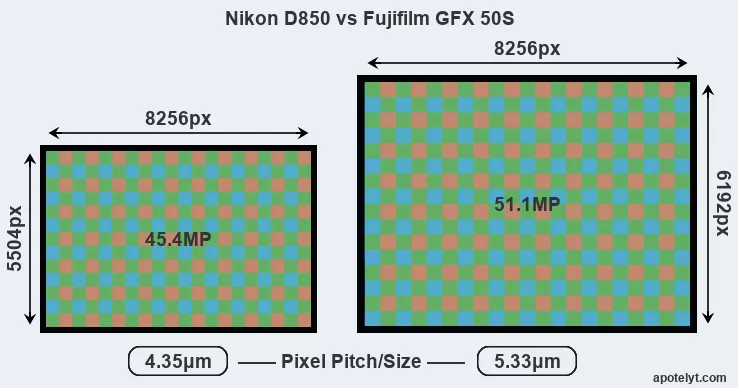
Since 2007, DXO Mark has published sensor performance measurements that have been derived using a consistent methodology. This service is based on lab testing and assigns an overall score to each camera sensor, as well as ratings for dynamic range ("DXO Landscape"), color depth ("DXO Portrait"), and low-light sensitivity ("DXO Sports"). The table below summarizes the physical sensor characteristics and sensor quality findings and compares them across a set of similar cameras.

| Camera Model |
Sensor Class |
Resolution (MP) |
Horiz. Pixels |
Vert. Pixels |
Video Format |
DXO Portrait |
DXO Landscape |
DXO Sports |
DXO Overall |
||
|---|---|---|---|---|---|---|---|---|---|---|---|
| 1. | Nikon D850 | Full Frame | 45.4 | 8256 | 5504 | 4K/30p | 26.4 | 14.8 | 2660 | 100 | |
| 2. | Fujifilm GFX 50S | Medium Format | 51.1 | 8256 | 6192 | 1080/30p | 25.4 | 14.1 | 2977 | 96 | |
| 3. | Canon 5DS | Full Frame | 50.3 | 8688 | 5792 | 1080/30p | 24.7 | 12.4 | 2381 | 87 | |
| 4. | Canon 5DS R | Full Frame | 50.3 | 8688 | 5792 | 1080/30p | 24.6 | 12.4 | 2308 | 86 | |
| 5. | Fujifilm GFX 50R | Medium Format | 51.1 | 8256 | 6192 | 1080/30p | 25.7 | 14.4 | 3169 | 98 | |
| 6. | Fujifilm GFX 50S II | Medium Format | 51.1 | 8256 | 6192 | 1080/30p | 25.9 | 14.8 | 3456 | 100 | |
| 7. | Hasselblad X1D II | Medium Format | 51.3 | 8272 | 6200 | 1080/25p | 25.7 | 14.5 | 3234 | 99 | |
| 8. | Leica M10 | Full Frame | 23.8 | 5952 | 3992 | none | 24.4 | 13.2 | 2133 | 86 | |
| 9. | Leica SL | Full Frame | 24.0 | 6000 | 4000 | 4K/30p | 25.0 | 13.4 | 1821 | 88 | |
| 10. | Nikon D5 | Full Frame | 20.7 | 5588 | 3712 | 4K/30p | 25.1 | 12.3 | 2343 | 88 | |
| 11. | Nikon D600 | Full Frame | 24.2 | 6016 | 4016 | 1080/30p | 25.1 | 14.2 | 2980 | 94 | |
| 12. | Nikon D610 | Full Frame | 24.2 | 6016 | 4016 | 1080/30p | 25.1 | 14.4 | 2925 | 94 | |
| 13. | Nikon D800 | Full Frame | 36.2 | 7360 | 4912 | 1080/30p | 25.3 | 14.4 | 2853 | 95 | |
| 14. | Nikon D800E | Full Frame | 36.2 | 7360 | 4912 | 1080/30p | 25.6 | 14.3 | 2979 | 96 | |
| 15. | Nikon D810 | Full Frame | 36.2 | 7360 | 4912 | 1080/60p | 25.7 | 14.8 | 2853 | 97 | |
| 16. | Nikon Df | Full Frame | 16.2 | 4928 | 3280 | none | 24.6 | 13.1 | 3279 | 89 | |
| 17. | Sony A99 II | Full Frame | 42.2 | 7952 | 5304 | 4K/30p | 25.4 | 13.4 | 2317 | 92 | |
| Note: DXO values in italics represent estimates based on sensor size and age. | |||||||||||
Many modern cameras are not only capable of taking still images, but also of capturing video footage. Both cameras under consideration are equipped with sensors that have a sufficiently high read-out speed for moving images, but the D850 provides a higher video resolution than the GFX 50S. It can shoot video footage at 4K/30p, while the Fujifilm is limited to 1080/30p.
Feature comparison
Apart from body and sensor, cameras can and do differ across a range of features. For example, the D850 has an optical viewfinder, which can be very useful when shooting in bright sunlight. In contrast, the GFX 50S relies on live view and the rear LCD for framing. That said, the GFX 50S can be equipped with an optional viewfinder – the EVF-TL1. The table below summarizes some of the other core capabilities of the Nikon D850 and Fujifilm GFX 50S in connection with corresponding information for a sample of similar cameras.

| Camera Model |
Viewfinder (Type or 000 dots) |
Control Panel (yes/no) |
LCD Specifications (inch/000 dots) |
LCD Attach- ment |
Touch Screen (yes/no) |
Max Shutter Speed * |
Max Shutter Flaps * |
Built-in Flash (yes/no) |
Built-in Image Stab |
||
|---|---|---|---|---|---|---|---|---|---|---|---|
| 1. | Nikon D850 | optical | Y | 3.2 / 2359 | tilting | Y | 1/8000s | 9.0/s | n | n | |
| 2. | Fujifilm GFX 50S | optional | Y | 3.2 / 2360 | full-flex | Y | 1/4000s | 3.0/s | n | n | |
| 3. | Canon 5DS | optical | Y | 3.2 / 1040 | fixed | n | 1/8000s | 5.0/s | n | n | |
| 4. | Canon 5DS R | optical | Y | 3.2 / 1040 | fixed | n | 1/8000s | 5.0/s | n | n | |
| 5. | Fujifilm GFX 50R | 3690 | n | 3.2 / 2360 | tilting | Y | 1/4000s | 3.0/s | n | n | |
| 6. | Fujifilm GFX 50S II | 3690 | Y | 3.2 / 2360 | full-flex | Y | 1/4000s | 3.0/s | n | Y | |
| 7. | Hasselblad X1D II | 3690 | n | 3.6 / 2360 | fixed | Y | 1/2000s | 2.7/s | n | n | |
| 8. | Leica M10 | optical | n | 3.0 / 1037 | fixed | n | 1/4000s | 5.0/s | n | n | |
| 9. | Leica SL | 4400 | Y | 3.0 / 1040 | fixed | Y | 1/8000s | 11.0/s | n | n | |
| 10. | Nikon D5 | optical | Y | 3.2 / 2359 | fixed | Y | 1/8000s | 14.0/s | n | n | |
| 11. | Nikon D600 | optical | Y | 3.0 / 921 | fixed | n | 1/4000s | 5.5/s | Y | n | |
| 12. | Nikon D610 | optical | Y | 3.2 / 921 | fixed | n | 1/4000s | 6.0/s | Y | n | |
| 13. | Nikon D800 | optical | Y | 3.2 / 921 | fixed | n | 1/8000s | 4.0/s | Y | n | |
| 14. | Nikon D800E | optical | Y | 3.2 / 921 | fixed | n | 1/8000s | 4.0/s | Y | n | |
| 15. | Nikon D810 | optical | Y | 3.2 / 1229 | fixed | n | 1/8000s | 5.0/s | Y | n | |
| 16. | Nikon Df | optical | Y | 3.2 / 921 | fixed | n | 1/4000s | 5.5/s | n | n | |
| 17. | Sony A99 II | 2400 | Y | 3.0 / 1229 | full-flex | n | 1/8000s | 12.0/s | n | Y | |
| Note: *) Information refers to the mechanical shutter, unless the camera only has an electronic one. | |||||||||||
The reported shutter speed information refers to the use of the mechanical shutter. Yet, some cameras only have an electronic shutter, while others have an electronic shutter in addition to a mechanical one. In fact, the GFX 50S is one of those camera that have an additional electronic shutter, which makes completely silent shooting possible. However, this mode is less suitable for photographing moving objects (risk of rolling shutter) or shooting under artificial light sources (risk of flickering).
The Nikon D850 and the Fujifilm GFX 50S both have an intervalometer built-in. This enables the photographer to capture time lapse sequences, such as flower blooming, a sunset or moon rise, without purchasing an external camera trigger and related software.
The D850 writes its imaging data to SDXC or XQD cards, while the GFX 50S uses SDXC cards. Both cameras feature dual card slots, which can be very useful in case a memory card fails. Moreover, both cameras support UHS-II cards (Ultra High Speed data transfer of up to 312 MB/s).
Connectivity comparison
For some imaging applications, the extent to which a camera can communicate with its environment can be an important aspect in the camera decision process. The table below provides an overview of the connectivity of the Nikon D850 and Fujifilm GFX 50S and, in particular, the interfaces the cameras (and selected comparators) provide for accessory control and data transfer.

| Camera Model |
Hotshoe Port |
Internal Mic / Speaker |
Microphone Port |
Headphone Port |
HDMI Port |
USB Port |
WiFi Support |
NFC Support |
Bluetooth Support |
||
|---|---|---|---|---|---|---|---|---|---|---|---|
| 1. | Nikon D850 | Y | stereo / mono | Y | Y | mini | 3.0 | Y | Y | Y | |
| 2. | Fujifilm GFX 50S | Y | stereo / mono | Y | Y | micro | 3.0 | Y | - | - | |
| 3. | Canon 5DS | Y | mono / mono | Y | - | mini | 3.0 | - | - | - | |
| 4. | Canon 5DS R | Y | mono / mono | Y | - | mini | 3.0 | - | - | - | |
| 5. | Fujifilm GFX 50R | Y | stereo / mono | Y | Y | micro | 3.0 | Y | - | Y | |
| 6. | Fujifilm GFX 50S II | Y | stereo / mono | Y | Y | micro | 3.2 | Y | - | - | |
| 7. | Hasselblad X1D II | Y | stereo / mono | Y | Y | - | 3.0 | Y | - | - | |
| 8. | Leica M10 | Y | - / - | - | - | - | - | Y | - | - | |
| 9. | Leica SL | Y | stereo / mono | Y | Y | full | 3.0 | Y | - | - | |
| 10. | Nikon D5 | Y | stereo / mono | Y | Y | mini | 3.0 | - | - | - | |
| 11. | Nikon D600 | Y | mono / mono | Y | Y | mini | 2.0 | - | - | - | |
| 12. | Nikon D610 | Y | mono / mono | Y | Y | mini | 2.0 | - | - | - | |
| 13. | Nikon D800 | Y | mono / mono | Y | Y | mini | 3.0 | - | - | - | |
| 14. | Nikon D800E | Y | mono / mono | Y | Y | mini | 3.0 | - | - | - | |
| 15. | Nikon D810 | Y | stereo / mono | Y | Y | mini | 3.0 | Y | - | - | |
| 16. | Nikon Df | Y | - / - | - | - | mini | 2.0 | - | - | - | |
| 17. | Sony A99 II | Y | stereo / mono | Y | Y | micro | 2.0 | Y | Y | Y |
Both cameras feature a PC Sync terminal to control professional strobe lights, which will be appreciated by studio photographers.
The D850 is a recent model that features in the current product line-up of Nikon. In contrast, the GFX 50S has been discontinued (but can be found pre-owned on ebay). As a replacement in the same line of cameras, the GFX 50S was succeeded by the Fujifilm GFX 50S II. Further information on the features and operation of the D850 and GFX 50S can be found, respectively, in the Nikon D850 Manual (free pdf) or the online Fujifilm GFX 50S Manual.
Review summary
So how do things add up? Is the Nikon D850 better than the Fujifilm GFX 50S or vice versa? The listing below highlights the relative strengths of the two models.

Advantages of the Nikon D850:
- Better video: Provides higher definition movie capture (4K/30p vs 1080/30p).
- Easier framing: Has an optical viewfinder for image composition and settings control.
- Faster shutter: Has higher mechanical shutter speed (1/8000s vs 1/4000s) to freeze action.
- Faster burst: Shoots at higher frequency (9 vs 3 flaps/sec) to capture the decisive moment.
- Longer lasting: Can take more shots (1840 versus 400) on a single battery charge.
- Easier device pairing: Supports NFC for fast wireless image transfer over short distances.
- Easier wireless transfer: Supports Bluetooth for image sharing without cables.
- More affordable: Was introduced into a lower priced category (49 percent cheaper at launch).
- More modern: Is somewhat more recent (announced 10 months after the GFX 50S).

Reasons to prefer the Fujifilm GFX 50S:
- Better image quality: Features bigger pixels on a larger sensor for higher quality imaging.
- Richer colors: The pixel size advantage translates into images with better, more accurate colors.
- More dynamic range: Larger pixels capture a wider spectrum of light and dark details.
- Better low-light sensitivity: Larger pixels means good image quality even under poor lighting.
- More flexible LCD: Has a full-flex screen for odd-angle shots in portrait or landscape orientation.
- Less disturbing: Has an electronic shutter option for completely silent shooting.
- More compact: Is smaller (148x94mm vs 146x124mm) and will fit more readily into a bag.
- Less heavy: Has a lower weight (by 265g or 26 percent) and is thus easier to take along.
- More legacy lens friendly: Can use many non-native lenses via adapters.
- More heavily discounted: Has been on the market for longer (launched in September 2016).
If the count of individual advantages (bullet points above) is taken as a guide, the GFX 50S comes out slightly ahead of the D850 (10 : 9 points). However, the relevance of individual strengths will vary across photographers, so that you might want to apply your own weighing scheme to the summary points when reflecting and deciding on a new camera. A professional wildlife photographer will view the differences between cameras in a way that diverges from the perspective of a family photog, and a person interested in architecture has distinct needs from a sports shooter. Hence, the decision which camera is best and worth buying is often a very personal one.
How about other alternatives? Do the specifications of the Nikon D850 and the Fujifilm GFX 50S place the cameras among the top in their class? Find out in the latest Best DSLR Camera and Best Mirrorless Interchangeable Lens Camera listings whether the two cameras rank among the cream of the crop.
In any case, while the specs-based evaluation of cameras can be instructive in revealing their potential as photographic tools, it remains partial and cannot reveal, for example, the shooting experience and imaging performance when actually working with the D850 or the GFX 50S. At times, user reviews, such as those published at amazon, address these issues in a useful manner, but such feedback is on many occasions incomplete, inconsistent, and unreliable.
Expert reviews
This is why expert reviews are important. The table below provides a synthesis of the camera assessments of some of the best known photo-gear review sites (amateurphotographer [AP], cameralabs [CL], digitalcameraworld [DCW], dpreview [DPR], ephotozine [EPZ], photographyblog [PB]). As can be seen, the professional reviewers agree in many cases on the quality of different cameras, but sometimes their assessments diverge, reinforcing the earlier point that a camera decision is often a very personal choice.

| Camera Model |
AP score |
CL score |
DCW score |
DPR score |
EPZ score |
PB score |
Camera Launch |
Launch Price (USD) |
Street Price |
||
|---|---|---|---|---|---|---|---|---|---|---|---|
| 1. | Nikon D850 | 4.5/5 | + + | 5/5 | 89/100 | 4.5/5 | 5/5 | Jul 2017 | 3,299 | amazon.com | |
| 2. | Fujifilm GFX 50S | .. | .. | 4.5/5 | 85/100 | 5/5 | 4.5/5 | Sep 2016 | 6,499 | ebay.com | |
| 3. | Canon 5DS | .. | + | .. | 83/100 | 4.5/5 | 4.5/5 | Feb 2015 | 3,699 | ebay.com | |
| 4. | Canon 5DS R | 5/5 | + | .. | 83/100 | 5/5 | 4.5/5 | Feb 2015 | 3,699 | ebay.com | |
| 5. | Fujifilm GFX 50R | 5/5 | .. | 5/5 | 84/100 | 4.5/5 | 4.5/5 | Sep 2018 | 4,499 | ebay.com | |
| 6. | Fujifilm GFX 50S II | 5/5 | .. | 5/5 | 87/100 | .. | 5/5 | Sep 2021 | 3,999 | amazon.com | |
| 7. | Hasselblad X1D II | .. | .. | 4/5 | .. | 4/5 | 4/5 | Jun 2019 | 5,750 | ebay.com | |
| 8. | Leica M10 | 4.5/5 | .. | .. | .. | 4/5 | 4.5/5 | Jan 2017 | 6,595 | ebay.com | |
| 9. | Leica SL | 4/5 | .. | 4/5 | 84/100 | 4.5/5 | 4/5 | Oct 2015 | 7,450 | ebay.com | |
| 10. | Nikon D5 | .. | .. | 4/5 | 89/100 | 4.5/5 | 5/5 | Jan 2016 | 6,499 | ebay.com | |
| 11. | Nikon D600 | 4/5 | + + | .. | 87/100 | 5/5 | 4.5/5 | Sep 2012 | 2,099 | ebay.com | |
| 12. | Nikon D610 | 4/5 | + + | .. | 87/100 | 4.5/5 | 4.5/5 | Oct 2013 | 1,999 | ebay.com | |
| 13. | Nikon D800 | 5/5 | + + | .. | 82/100 | 5/5 | 5/5 | Feb 2012 | 2,999 | ebay.com | |
| 14. | Nikon D800E | .. | .. | .. | 84/100 | 5/5 | 5/5 | Feb 2012 | 3,299 | ebay.com | |
| 15. | Nikon D810 | 5/5 | .. | 5/5 | 86/100 | 5/5 | 4.5/5 | Jun 2014 | 3,299 | ebay.com | |
| 16. | Nikon Df | 4/5 | .. | .. | 81/100 | 4/5 | 4/5 | Nov 2013 | 2,749 | ebay.com | |
| 17. | Sony A99 II | .. | .. | 4.5/5 | 85/100 | 4.5/5 | 4.5/5 | Sep 2016 | 3,199 | ebay.com | |
| Note: (+ +) highly recommended; (+) recommended; (o) reviewed; (..) not available. | |||||||||||
The review scores listed above should be treated with care, though. The assessments were made in relation to similar cameras of the same technological generation. Hence, a score should always be seen in the context of the camera's market launch date and its price, and comparisons of ratings among very different cameras or across long time periods have little meaning. It should also be noted that some of the review sites have over time altered the way they render their verdicts.

Check D850 price at
amazon.com

Check GFX 50S offers at
ebay.com
Other camera comparisons
Did this review help to inform your camera decision process? In case you are interested in seeing how other cameras pair up, just make your choice using the following search menu. As an alternative, you can also directly jump to any one of the listed comparisons that were previously generated by the CAM-parator tool.
- Canon G9 X vs Fujifilm GFX 50S
- Canon R5 vs Fujifilm GFX 50S
- Canon R6 vs Fujifilm GFX 50S
- Canon SX500 vs Nikon D850
- Canon T4i vs Nikon D850
- Fujifilm GFX 50S vs Olympus E-PL3
- Fujifilm GFX 50S vs Panasonic ZS70
- Fujifilm GFX 50S vs Sony A9
- Leica S1 vs Nikon D850
- Nikon D850 vs Olympus TG-4
- Nikon D850 vs Pentax K-S1
- Nikon D850 vs Sony A6300
Specifications: Nikon D850 vs Fujifilm GFX 50S
Below is a side-by-side comparison of the specs of the two cameras to facilitate a quick review of their differences and common features.
| Camera Model | Nikon D850 | Fujifilm GFX 50S |
|---|---|---|
| Camera Type | Digital single lens reflex | Mirrorless system camera |
| Camera Lens | Nikon F mount lenses | Fujifilm G mount lenses |
| Launch Date | July 2017 | September 2016 |
| Launch Price | USD 3,299 | USD 6,499 |
| Sensor Specs | Nikon D850 | Fujifilm GFX 50S |
| Sensor Technology | BSI-CMOS | CMOS |
| Sensor Format | Full Frame Sensor | Medium Format Sensor |
| Sensor Size | 35.9 x 23.9 mm | 44.0 x 33.0 mm |
| Sensor Area | 858.01 mm2 | 1452 mm2 |
| Sensor Diagonal | 43.1 mm | 55 mm |
| Crop Factor | 1.0x | 0.79x |
| Sensor Resolution | 45.4 Megapixels | 51.1 Megapixels |
| Image Resolution | 8256 x 5504 pixels | 8256 x 6192 pixels |
| Pixel Pitch | 4.35 μm | 5.33 μm |
| Pixel Density | 5.30 MP/cm2 | 3.52 MP/cm2 |
| Moiré control | no AA filter | no AA filter |
| Movie Capability | 4K/30p Video | 1080/30p Video |
| ISO Setting | 64 - 25,600 ISO | 100 - 12,800 ISO |
| ISO Boost | 32 - 102,400 ISO | 50 - 102,400 ISO |
| Image Processor | EXPEED 5 | X Processor Pro |
| DXO Sensor Quality (score) | 100 | .. |
| DXO Color Depth (bits) | 26.4 | .. |
| DXO Dynamic Range (EV) | 14.8 | .. |
| DXO Low Light (ISO) | 2660 | .. |
| Screen Specs | Nikon D850 | Fujifilm GFX 50S |
| Viewfinder Type | Optical viewfinder | Viewfinder optional |
| Viewfinder Field of View | 100% | |
| Viewfinder Magnification | 0.75x | |
| Top-Level Screen | Control Panel | Control Panel |
| LCD Framing | Live View | Live View |
| Rear LCD Size | 3.2inch | 3.2inch |
| LCD Resolution | 2359k dots | 2360k dots |
| LCD Attachment | Tilting screen | Fully flexible screen |
| Touch Input | Touchscreen | Touchscreen |
| Shooting Specs | Nikon D850 | Fujifilm GFX 50S |
| Focus System | Phase-detect AF | Contrast-detect AF |
| Manual Focusing Aid | no Peaking Feature | Focus Peaking |
| Max Shutter Speed (mechanical) | 1/8000s | 1/4000s |
| Continuous Shooting | 9 shutter flaps/s | 3 shutter flaps/s |
| Electronic Shutter | no E-Shutter | up to 1/16000s |
| Time-Lapse Photography | Intervalometer built-in | Intervalometer built-in |
| Fill Flash | no On-Board Flash | no On-Board Flash |
| Storage Medium | SDXC or XQD cards | SDXC cards |
| Single or Dual Card Slots | Dual card slots | Dual card slots |
| UHS card support | UHS-II | Dual UHS-II |
| Connectivity Specs | Nikon D850 | Fujifilm GFX 50S |
| External Flash | Hotshoe | Hotshoe |
| Studio Flash | PC Sync socket | PC Sync socket |
| USB Connector | USB 3.0 | USB 3.0 |
| HDMI Port | mini HDMI | micro HDMI |
| Microphone Port | External MIC port | External MIC port |
| Headphone Socket | Headphone port | Headphone port |
| Wifi Support | Wifi built-in | Wifi built-in |
| Near-Field Communication | NFC built-in | no NFC |
| Bluetooth Support | Bluetooth built-in | no Bluetooth |
| Body Specs | Nikon D850 | Fujifilm GFX 50S |
| Environmental Sealing | Weathersealed body | Weathersealed body |
| Battery Type | Nikon EN-EL15a | Fujifilm NP-T125 |
| Battery Life (CIPA) | 1840 shots per charge | 400 shots per charge |
| Body Dimensions |
146 x 124 x 79 mm (5.7 x 4.9 x 3.1 in) |
148 x 94 x 91 mm (5.8 x 3.7 x 3.6 in) |
| Camera Weight | 1005 g (35.5 oz) | 740 g (26.1 oz) |

Check D850 price at
amazon.com

Check GFX 50S offers at
ebay.com
Did you notice an error on this page? If so, please get in touch, so that we can correct the information.

